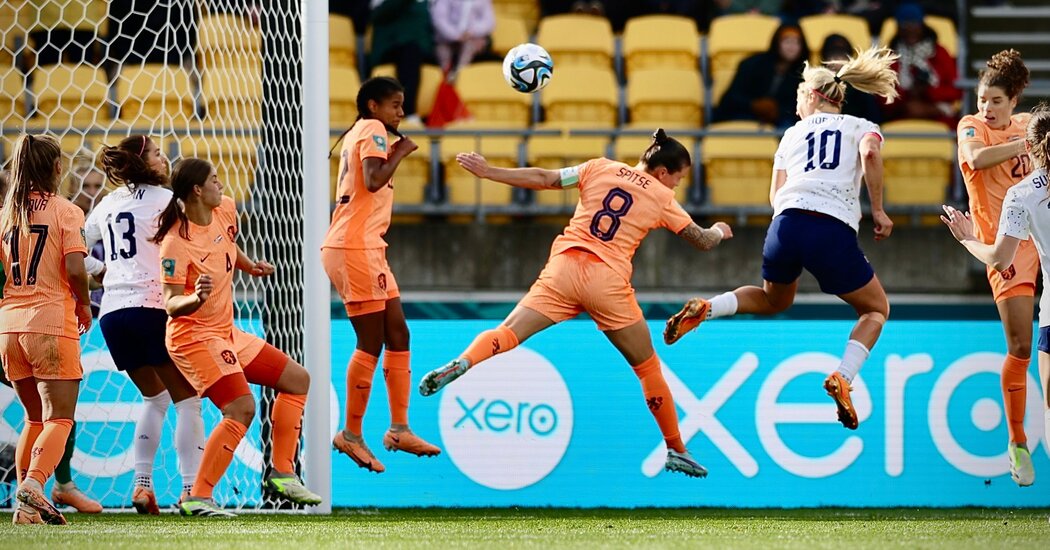Lindsey Horan was still curled up on the field when she decided, enough already.
Enough of getting kicked by players from the Netherlands. Enough of letting the Dutch dictate the game. Enough of the United States women’s team, the two-time reigning world champion, not playing its best at this Women’s World Cup.
Horan and her team were an hour into a physical match against the Netherlands filled with sharp elbows and powerful shoves, and they were losing it by a goal. Now Horan, a United States co-captain, had just been hip-checked hard by a Netherlands counterpart, Danielle van de Donk. So after several minutes of being examined by medical staff, and another moment of being lectured by the referee for shoving van de Donk, Horan did exactly what her teammate Julie Ertz had just begged her to do.
“Just score this goal,” Ertz had whispered as they lined up to await a corner kick from Rose Lavelle, “to shut everyone up.”
And that’s just what she did. As Rose Lavelle’s corner screamed into the penalty area, Horan sprinted for the precise spot where it would arrive. “An absolute dime,” she called the pass from Lavelle. She jumped to meet it, snapped her head and sent the ball straight into the net.
“I don’t think you ever want to get me mad because I don’t react in a good way,” Horan said. “Usually, I just go and I want something more. I want to win more. I want to score more. I want to do more for my team.”
Horan’s goal lifted the United States to a 1-1 tie with the Netherlands, with one more group match game to play for each team. At the moment, the teams are tied with 4 points from a win and a draw, but the United States holds a slight edge on goal difference because it beat Vietnam by three goals and the Netherlands beat Portugal by only one.
The winner of the group will be decided after the third and final matches in the group, which will be played simultaneously on Tuesday. The U.S. will face Portugal, and the Netherlands will play Vietnam.
The United States will enter that game with a new spring in its step, and Horan is the main reason for that. All it took, it turned out, was a bit of rage.
“That’s when you get the best football from Lindsey,” Horan said of herself.
She is not the first U.S. women’s player, of course, to take it upon herself to personally change the team’s trajectory at a World Cup, to will it to victory on soccer’s biggest stage. Think Megan Rapinoe in 2019, or Carli Lloyd in the 2015 final, to take two recent examples. In each case, and in Horan’s on Thursday, a key player suddenly came to personify the team’s history and legacy — four World Cup titles, four decades atop world soccer — and turn the momentum her team’s way.
On Thursday, even Horan’s teammates sensed something was about to change. Forward Alex Morgan said that when she saw the referee pull Horan and van de Donk aside after the two exchanged shoves and heated words following the foul, and just before the corner kick that ensued, she “felt like something was going to happen.”
United States Coach Vlatko Andonovski said the response was typical of Horan.
“She gets fouled, kicked, hurt and obviously it’s a very difficult moment,” Andonovski said. “And instead of crying about it, she just goes and makes a statement, and basically that shows everyone in the world the direction that the game is going to take.”
Andonovski said he was especially proud that Horan and other veterans had continued to press for a winning goal after Horan tied the score, showing the younger players on the U.S. team how to take control of a game. Horan and players like Ertz and Lavelle, he said, “carried the younger ones, or in a way showed the younger ones what this game is all about.”
One of those players, the 21-year-old Trinity Rodman, said she had been impressed by Horan’s ability to “flip a switch” and go “from trash talking to putting a ball in the back of the net.”
It may have been why Andonovski chose to make only one substitution in Thursday’s game, sending on Lavelle for Savannah DeMelo at halftime to try to inject some energy into the U.S. midfield. He refrained from making more changes, he said, “because I thought we had control of the game, I thought we were knocking on the door of scoring a goal.”
“We were around the goal the whole time,” he added, “and I just didn’t want to disrupt the rhythm.”
It was only after Horan’s goal, though, and after being outplayed in the first half, that the United States began to look crisper and more determined.
Andonovski suggested that the final 30 minutes, not the first 60, were representative of what he and fans could expect as the team moves deeper into the tournament, and as the connections between players young and old start to get more familiar.
“What you saw in the second half is what you’re going to see going forward, as a baseline,” he said. “I think that we’re just going to get better from game to game, and we’re going to be a lot more efficient as well.”
Sumber: www.nytimes.com








